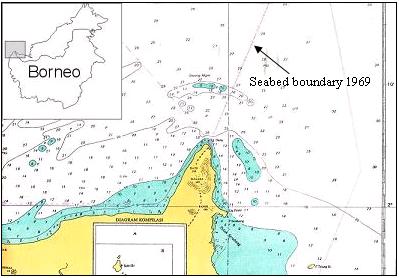I Made Andi Arsana
It seems that cases concerning international boundaries between Indonesia and Malaysia do not stop from arising. Ambalat, the latest case causing tension built last year was apparently not the last one. While the negotiation series of the Ambalat case are even being undertaken, another issue sparks. Gosong Niger is the one that is currently becoming a hot issue, as always, in Indonesia. Not sure whether such issue is a serious concern in Malaysia.
The issue sparked when the fishing ship of West Kalimantan’s Office of Marine Affairs and Fisheries happened to be located 0.7 nautical miles from the boundary line within Malaysian territory during conducting a survey. Malaysian Navy, Tentara Laut Diraja Malaysia, suspected that this is a territorial trespassing that Indonesian ship has done. Gosong Niger lies in the border area between Indonesia and Malaysia, where the case took place. It extends over an area of some 50 sq kilometres stretching from west to east (Tempo, February 2006). The term “gosong” is apparently not a proper English. It refers to a submerged ridge of alluvial sand in shallow water, which in English is known as sandbar. See Figure 1.

Figure 1 Gosong Niger
Another issue was then discovered that Malaysian Navy usually conducts patrol around Gosong Niger and does not allow Indonesian fishermen fishing in the area. Some sources said that the traditional fishermen generally do not know that the area is under Indonesian sovereignty as they could see Malaysian ship parking in the area almost everyday. Consequently, the Indonesian fishermen have no access to the natural resources around Gosong Niger.
With respect to the existing seabed boundary between Indonesia and Malaysia 1969, Gosong Niger is part of the seabed that is divided by the boundary line where two third of the seabed fall within the Indonesian side. With regard to this, the ownership of the sandbar is considerably clear. As there is a precise line, it should have been clear who own which seabed.
However, it has to be remembered that no territorial sea boundary has been established between Indonesia and Malaysia in that area (north of Tanjung Datu). In other words the two states have agreed a seabed boundary but have not yet agreed a boundary for the water column. This means that the arrangement for sovereignty over the territorial sea in the area is not yet clear. Consequently, no judgment can be made stating that Indonesian or Malaysian ship has done territorial trespassing. However, by de facto, the existing seabed boundary is, unfortunately, recognised as the territorial sea boundary as well. This might be the reason why Indonesia or Malaysia suspects that the activities within the territorial water were boundary infringements.
As two adjacent states in Borneo Island, Indonesia and Malaysia have overlapping claim with regards to territorial sea in the area of Gosong Niger. The absence of territorial sea boundary between Indonesia and Malaysia, consequently, leaves an uncertainty regarding the sovereignty over the territorial sea (water column). If Malaysians or Indonesians go beyond the boundary line, but still in the water column without touching the seabed, they do not infringe any agreement/law. The prosecution can only be made when Indonesians or Malaysians cross the seabed boundary line and conduct activities involving seabed of Gosong Niger.
Media says that Malaysia has established a permanent tourism service around the area and provide facilities for diving, swimming, and other aqua-tourism activities around Gosong Niger. If it is true, it might worth confirming that it is not an acceptable practice as the boundary between Indonesia and Malaysia has not been agreed. If the activities involve seabed exploration or exploitation, these can be considered as infringement.
Some opinions in Indonesia said that this is similar to the case of Sipadan and Ligitan, where Malaysia will finally be granted the sovereignty over Gosong Niger because it has been demonstrating effective occupation over the sandbar. It is actually not the case. There is a permanent and agreed boundary line between Indonesia and Malaysia in Gosong Niger, but not in Celebes Sea where Pulau Sipadan and Ligitan lie. The absence of permanent boundary line in Celebes Sea, ant the lack of legal official claims were the reason why the sovereignty over the two islands were disputed. In that case, the effective occupation (Effectivités) was a relevant consideration to decide the sovereignty over Pulau Sipadan and Ligitan. In contrast, the “ownership” of Gosong Niger has been made clear by the existence of a seabed boundary agreed in 1969. The infringement conducted by either Malaysia or Indonesia has nothing to do with its sovereignty.
This case is by no mean similar with Ambalat dispute. The Ambalat dispute, being in Celebes Sea, was due to the absence of permanent seabed boundary. In contrary, the seabed boundary in Gosong Niger has been clear so there is no need to establish a new seabed boundary unlike what is required with regard to Ambalat.
It seems that international boundary disputes have been one of Indonesia’s major problems lately. Many cases regarding international boundary, sovereignty and sovereign rights have caught everybody’s attention, including Ambalat case, island ownerships/disputes, Gosong Niger, border crime, ship piracy, etc. Many suggestions have been addressed to government and corresponding bodies but it seems that the reaction has been far for acceptable. Cases keep arising. It is understandable that the government is currently struggling with other bigger and more strategic issues such as corruption and natural hazards but it does not mean that the issue regarding international boundary and sovereignty/sovereign rights can be put in the last line and treated as the least priority.


No comments:
Post a Comment